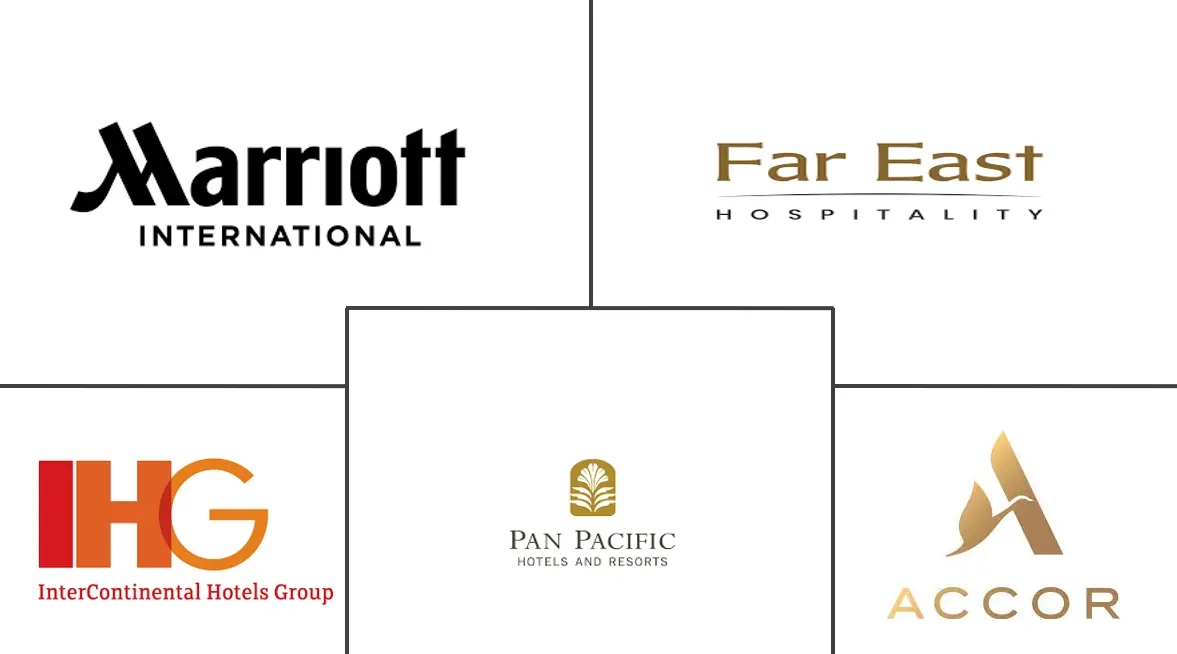Market Size of Hospitality Industry In Singapore

| Study Period | 2020 - 2029 |
| Base Year For Estimation | 2023 |
| Market Size (2024) | USD 4.43 Billion |
| Market Size (2029) | USD 5.46 Billion |
| CAGR (2024 - 2029) | 4.26 % |
| Market Concentration | Medium |
Major Players
*Disclaimer: Major Players sorted in no particular order |
Singapore Hospitality Market Analysis
The Hospitality Industry In Singapore Market size is estimated at USD 4.43 billion in 2024, and is expected to reach USD 5.46 billion by 2029, growing at a CAGR of 4.26% during the forecast period (2024-2029).
Over the past ten years, Singapore has witnessed an increase in the number of tourists. A DBS Bank analysis claims there need to be more hotels or other lodging options nationwide to accommodate the increasing number of visitors. Over the past ten years, the average number of tourists to each country has increased by 6%, but the supply of hotel rooms has only increased by 4.2%, particularly in the last four years, which has put pressure on the nation's tourism sector. Singapore has revolutionized the hotel sector by establishing trends in areas such as technology innovation, sustainability, and holistic wellness.
Singapore is preparing itself for a change in consumer demand and emerging travel habits. To advance in the market, companies offering services related to hospitality will need to adopt a holistic health approach. After the pandemic, the Singapore government has actively promoted and launched various tourism initiatives such as a business travel lane that allows corporate and diplomatic travelers to skip quarantine on arrival and the launch of the "Air Travell Pass Program," which will enable tourists to apply to travel to Singapore without undergoing quarantine.
Singapore Hospitality Industry Segmentation
The hospitality sector encompasses a diverse array of service-based occupations, including accommodations, theme parks, travel agencies, food and beverage services, event management, hotels, restaurants, and bars. The research covers a comprehensive background examination of the Singaporean hospitality sector, including an evaluation of industry associations, the general economy, emerging market trends by category, notable shifts in the market dynamics, and a market overview. In Singapore, the hotel business is divided into two categories: independent and chain hotels, as well as service apartments, low-cost and budget hotels, mid- and upper-mid-range hotels, and luxury hotels. The report offers market size and forecasts for the hospitality industry in Singapore in terms of value (USD) for all the above segments.
| By Type | |
| Chain Hotels | |
| Independent Hotels |
| By Segment | |
| Service Apartments | |
| Budget and Economy Hotels | |
| Mid and Upper mid scale Hotels | |
| Luxury Hotels |
Hospitality Industry In Singapore Size Summary
The hospitality industry in Singapore is poised for growth, driven by an increasing influx of tourists and a strategic focus on innovation and sustainability. Over the past decade, Singapore has seen a steady rise in tourist numbers, although the supply of hotel accommodations has not kept pace, creating a demand-supply gap. This has prompted the industry to adopt new trends, particularly in technology, sustainability, and holistic wellness, to enhance the visitor experience. The Singapore government has also been proactive in promoting tourism through initiatives like the business travel lane and the Air Travel Pass Program, which facilitate easier access for corporate and diplomatic travelers. Despite competition from neighboring countries, Singapore continues to attract a significant number of leisure visitors, supported by effective marketing campaigns by the Singapore Tourism Board.
The market landscape is characterized by a mix of domestic and international players, with major companies like Accor SA, Pan Pacific Hotels Group, Marriott International, Far East Hospitality, and InterContinental Hotels Group Plc leading the charge. The demand for hotels remains strong, particularly in prime locations, making Singapore an attractive destination for investors. Recent developments, such as Accor's agreement to open the largest Mercure hotel in the world in Singapore, highlight the region's appeal. Additionally, partnerships like the one between Singapore Airlines Group and Sarovar Hotels & Resorts aim to enhance the travel experience by offering exclusive perks to travelers. As the market evolves, companies are increasingly focusing on Singapore's role as a business hub, catering to the needs of corporate groups with versatile meeting and leisure spaces.
Hospitality Industry In Singapore Market Size - Table of Contents
-
1. MARKET INSIGHTS AND DYNAMICS
-
1.1 Market Overview
-
1.2 Market Dynamics
-
1.2.1 Market Drivers
-
1.2.1.1 Contribution to the Economy to Generate Income for the Nation
-
1.2.1.2 Rise in Global Tourism
-
-
1.2.2 Market Restraints
-
1.2.2.1 Long Hours of Working Pattern
-
1.2.2.2 Increasing Competition among Hotels and Other Lodging Options
-
-
1.2.3 Market Opportunities
-
1.2.3.1 Technological Advancements Striving the Market
-
-
-
1.3 Value Chain Analysis
-
1.4 Porter's Five Forces Analysis
-
1.4.1 Bargaining Power of Suppliers
-
1.4.2 Bargaining Power of Buyers
-
1.4.3 Threat of New Entrants
-
1.4.4 Threat of Substitutes
-
1.4.5 Intensity of Competitive Rivalry
-
-
1.5 Technological Innovations and Recent Developments in the Hospitality Industry
-
1.6 Impact of COVID-19 on the Hospitality Industry
-
-
2. MARKET SEGMENTATION
-
2.1 By Type
-
2.1.1 Chain Hotels
-
2.1.2 Independent Hotels
-
-
2.2 By Segment
-
2.2.1 Service Apartments
-
2.2.2 Budget and Economy Hotels
-
2.2.3 Mid and Upper mid scale Hotels
-
2.2.4 Luxury Hotels
-
-
Hospitality Industry In Singapore Market Size FAQs
How big is the Hospitality Industry In Singapore Market?
The Hospitality Industry In Singapore Market size is expected to reach USD 4.43 billion in 2024 and grow at a CAGR of 4.26% to reach USD 5.46 billion by 2029.
What is the current Hospitality Industry In Singapore Market size?
In 2024, the Hospitality Industry In Singapore Market size is expected to reach USD 4.43 billion.

